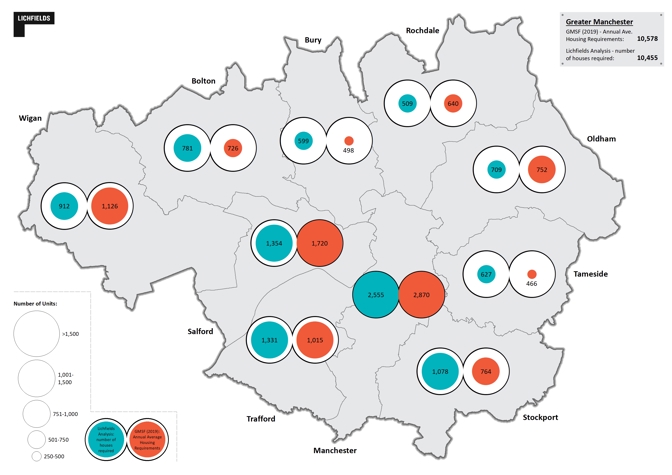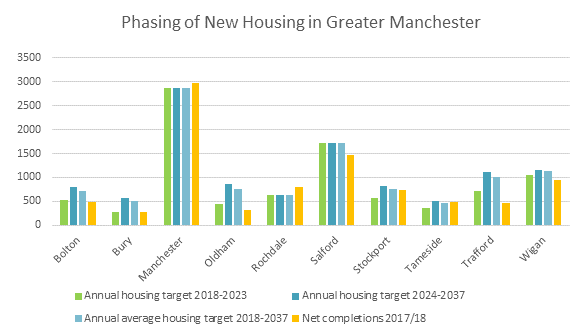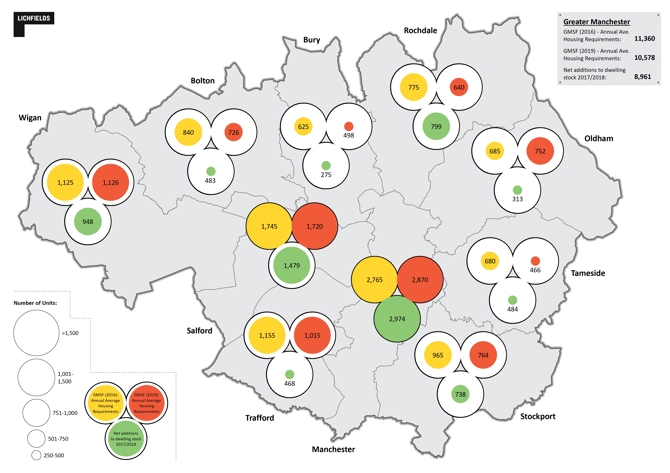After a two-year delay since the first draft version of the Greater Manchester Spatial Framework (GMSF) was published in October 2016, the revised draft was finally issued on Monday 7th January. This follows a mayoral manifesto pledge in 2017 for a ‘radical rewrite’ with ‘no net Green Belt losses’. This has ultimately been impossible to achieve, but nevertheless, important changes have been made to the development targets for both housing and employment land and where they will go. The revised draft was approved for consultation under Regulation 18 of the Town and Country Planning (Local Planning) (England) Regulations (2012) at the Greater Manchester Combined Authority’s (GMCA’s) meeting on Friday 11th January. The consultation is now open and will close on the 18th March 2019, with final consultation earmarked for September 2019 and adoption of the plan in December 2020.
The previous version of the document attracted 27,000 responses with the main concerns relating to Green Belt release for housing and employment, low density employment sites/low value warehousing and the infrastructure implications for new development.
This will be the first Spatial Development Strategy (SDS) outside of London. According to the GMCA, current legislation does not allow for an SDS of the type that the GMCA requires. Whilst the revised draft continues as a Development Plan Document, the GMCA want to convert it to an SDS which would not require the unanimous approval of all of the Councils, just the GMCA, and a whole host of issues will need to be examined closely in the weeks ahead to determine whether (as an SDS) the GMSF would be (1) subject to the tests of soundness, (2) able to allocate sites for development, and (3) able to amend Green Belt boundaries. Strong views either way have so far been expressed by the development industry.
The objective of the revised draft GMSF is to plan for homes, jobs, infrastructure and the environment in the ten combined authority areas of Bolton, Bury, Manchester, Oldham, Rochdale, Salford, Stockport, Tameside, Trafford and Wigan. The document claims to have overcome the main concerns with the 2016 draft and sets out its plans to:
-
Deliver a stronger emphasis on the role of brownfield land and town centres;
-
Reduce in the net loss of Green Belt; and,
-
Provide stronger protection of importance green spaces.
The question remains, to what extent has the detail been driven by political influences and a desire to protect Green Belt at all costs? Our view is that the GMSF suppresses development rather than actually providing the appropriate level of development needed in the most suitable areas to fulfil Manchester’s role as the engine of the Northern Powerhouse.
Two years ago, we raised concerns that the 2016 GMSF was pursuing conservative levels of housing, with employment growth levels well below what many other cities were achieving elsewhere in the UK. We were concerned that without a radically re-booted, pro-development GMSF, Greater Manchester would be unable to sustain the Northern Powerhouse, nor act as a healthy counterweight to London and the Greater South East. However, the latest version of the GMSF scales back the level of housing and economic development even further, making it even less likely that Greater Manchester can achieve its potential.
The Plan’s main emphasis is instead on delivering new development as part of a “brownfield-first” approach through higher density developments. The 50% reduction in site allocations within the Green Belt has (rightly) grabbed many of the headlines with the overall proposed net loss of Green Belt comprising 4.1% of Greater Manchester’s total Green Belt area (-2,049 ha), compared to 8.2% previously.
Housing
In terms of housing, the revised draft GMSF sets a target of 200,980 new homes to be delivered in Greater Manchester 2018-2037 (or 10,578 dwellings per annum (dpa)). This annual target has reduced by 7% since the 2016 draft, which required the delivery of 227,200 new homes over a 20-year period (11,360 dpa).
Figure 1: See larger version
The map at Figure 1 shows the housing targets for both the 2016 draft and the revised 2018 draft GMSF against past delivery rates
[1].
Whilst it is a positive that the GMCA is planning for an increase in recent levels of housing delivery, the proposed delivery rate would still be well below the delivery rate of almost 15,000 houses achieved just before the financial crisis in 2007/08 (almost 30% lower, in fact).
In terms of the methodology used in the revised draft GMSF to calculate this target, the GMCA follows the revised standard method proposed by the Government in its recent consultation on calculating ‘local housing need’, i.e. to use the 2014-based household projections with an affordability uplift. This derives a figure of around 10,500 across Greater Manchester. However, the GMCA has not distributed this need across the districts as per the standard method, but has instead redistributed the housing allocations based on policy objectives. The GMSF states that promoting higher levels of housing growth in central and northern districts will achieve a more balanced and sustainable pattern of growth, support local economies and reflect the availability of suitable sites.
This is shown in Figure 2 which compares the revised draft 2019 GMSF local housing targets for each borough against the local housing need (LHN) calculated using the revised standard method. As it stands, the approach appears to be flawed.

Figure 2: See larger version
Figure 2 shows there are clear disparities between the LHN and the revised GMSF targets in most areas, in particular Stockport (1,078 LHN, compared to the 764 dpa GMSF target). Bolton and Tameside, two of the most deprived districts in Greater Manchester, both have reduced housing targets, despite the draft GMSF policy claiming that housing growth has been used as a tool to boost prosperity and reduce inequalities.
Furthermore, the proposed distribution has no regard to the different housing market areas across Greater Manchester, and assumes that someone may be just as happy to settle in Wigan as they would be in Stockport.
Moreover, the Planning Practice Guidance sets out that the standard method should be the minimum starting point for calculating LHN. The standard method has no regard to changing economic circumstances or future demographic behaviour which could have an impact on the LHN. It appears that the GMCA has used this starting point to identify their targets but have made no attempt to justify the lack of uplift, which could help to meet affordable housing needs or, critically, properly align with economic growth aspirations.
The picture is even bleaker for those looking to get on the housing market any time soon. The revised draft GMSF has adopted a phased approach to delivering housing across the ten authorities. In other words, the GMCA proposes to backload delivery by lowering targets over the first 5 years and accelerate delivery in later years. The GMCA claims that there is a need to build up to a higher future delivery rate in order to obtain Government funding as well as the required masterplanning and infrastructure investments required to support development on the sites, including many of the allocations in the GMSF.

Figure 3
Looking at the graph in Figure 3 we can see that this has had a particularly significant effect on Bolton, Bury, Oldham, Stockport and Trafford. Looking specifically at Bolton, the GMSF provides no housing allocations in the Borough and therefore the justification behind a phased approach here is unclear. This suppression could assist in creating the illusion that these Greater Manchester authorities are demonstrating a five-year housing land supply, when in fact, they are knowingly underdelivering.
Overall, the GMSF singularly fails to take affordability issues into account. The GMSF notes that if insufficient new homes are provided to meet increasing demand, then there is a risk that affordability levels will worsen and people will not have access to suitable accommodation that meets their needs (para 7.4). It is hard to disagree with this. However, the GMSF ignores the point by cutting the housing targets in the two districts with by far the highest affordability ratios in Greater Manchester, Stockport and Trafford, with the latter currently experiencing house prices some 8.9 times higher than earnings. By restricting housing growth in these areas and planning for more homes in more deprived areas, it risks intensifying the gap between supply and demand, contributing to continued house price increases.
The revised draft GMSF also proposes a new policy (GM-H 4 Density of New Housing) which sets out minimum density requirements for new housing in Greater Manchester. These minimum density requirements are central to achieving the delivery of sites within existing brownfield sites within the urban area. However, the revised draft GMSF has little regard to site specific constraints such as flood risk, topography, ecology etc. which can reduce the net developable area of a site; nor does it have regard to the financial viability of delivering these (often complex) brownfield sites.
This is another area in which the revised draft GMSF does not take into account different housing markets. The policy risks placing too much emphasis on delivering high density apartments within urban centres. It does not take into account that many families want to live in larger suburban family homes with private outdoor amenity space. England is in the middle of a housing crisis with an ever-increasing need for more family homes. The GMSF therefore needs to plan for a range of family homes in a number of locations across the combined authorities.
There is also a strong, unmet demand for affordable housing across England. Policy GM-H 2 (Affordability of New Housing) sets out the GMCA’s aim to deliver at least 50,000 new affordable homes over the plan period (2018-2037) which equates to 25% of the total 200,000 homes to be delivered (2,632 annually).
Greater Manchester is currently delivering an average of 1,211 affordable homes each year which is around half of the affordable housing required by the revised draft GMSF. To meet the affordable housing target, 25% of all dwellings would need to be delivered as affordable housing. This will be very challenging and, again, does not take into account viability considerations.
Employment
In terms of employment land, the revised draft GMSF sets out a target of 4,220,000 sqm of industrial and warehousing floorspace to be delivered in Greater Manchester over the plan period (or 222,105 sqm each year). The GMCA has trended forward past take up rates of B1c/B2 and B8 land and uplifted the resultant annual average by 25%.
The revised draft GMSF claims to make provision for an industrial and warehousing supply (5,358,041 sqm) considerably higher than the overall ‘need’ to reflect the need to compete internationally for investment and provide sufficient choice and flexibility.
However, compared to the 2016 draft GMSF, there has been a substantial reduction in the gap between the target and the projected supply. The total supply for Greater Manchester set out in 2016 draft GMSF exceeded the target figure by 103%[2], whereas the total supply set out in the revised 2018 draft GMSF only exceeds the target figure by 27%.
It is evident that the GMCA are providing more industrial and warehousing floorspace than their ‘need’ which is positive; we agree that many of these potential allocations, particularly in the north, are suitable and deliverable however the level of supply has decreased substantially. However we think more industrial/warehousing allocations need to come forward to enhance competitiveness and flexibility in the supply.
Conclusion
In summary, it is a relief that the revised draft GMSF has finally been published and it is evident that the GMCA is working hard towards adopting a Plan that grapples with the issue of the Green Belt release. However in reality, more sites, both housing and industrial/warehousing, need to come forward in areas of greatest need. The GMCA cannot afford to supress the housing delivery that is essential to sustain Greater Manchester’s economic growth.
[1] 8,961 net housing completions in Greater Manchester in 2017/18.
[2] The 2016 draft GMSF made a provision of 8,126,000 sq m of industrial and warehousing supply with a target to deliver 4,000,000 sq m across the plan period.






